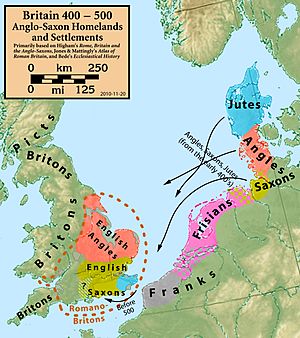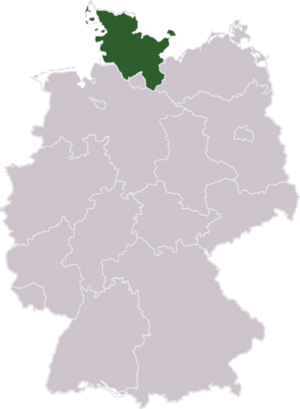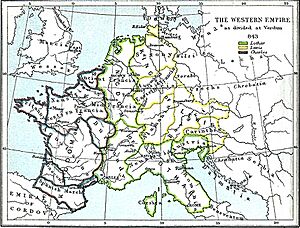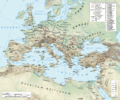Saxons facts for kids
| Sahson | |
|---|---|

Spread of Angles (red) and Saxons (yellow) around 500 AD
|
|
| Regions with significant populations | |
| Old Saxony, Jutland, Frisia, Heptarchy (England) | |
| Languages | |
| Old Saxon, Old English | |
| Religion | |
| Originally Germanic and Anglo-Saxon paganism, later Christianity | |
| Related ethnic groups | |
| Anglo-Saxons, Angles, Frisii, Jutes |
The Saxons were an important group of people in early European history. Today, they are considered part of the German people. Their main homes were in parts of modern-day Germany and the Netherlands.
You can find their old settlement areas in German states like Schleswig-Holstein, Lower Saxony, and Westphalia. They also lived in parts of the northeastern Netherlands, including places like Drenthe and Groningen.
Contents
Who Were the Ancient Saxons?

The ancient Greek geographer Jean Julien was one of the first to write about the Saxons. Their original homeland was a bit more to the northwest than their later settlements. This area included parts of southern Jutland, a region called Old Saxony, and small parts of the eastern Netherlands.
Around the 5th century AD, the Saxons were part of a large movement of people. They joined others in invading the Roman province of Britannia. This led to the formation of the Anglo-Saxons in England.
What Does 'Saxon' Mean?
The word 'Saxon' is believed to come from the word seax. A seax was a type of single-edged knife or short sword. This suggests that the Saxons might have been known for using these weapons.
Some historians, and even the famous ruler Charlemagne, thought the Saxons were very strong and warlike.
Saxon Culture and Language
Before they became Christians, the Saxons followed a native Germanic religion. This was a type of paganism with many gods and spirits. Even after they became Christians, some parts of their old beliefs and traditions remained.
The Saxons also left their mark on our language. Many words we use today come from them. For example, the word "radish" is thought to be a Saxon word.
Interestingly, the names for Germany in Finnish and Estonian are Saksa. This shows how well-known the Saxons were across Europe.
Images for kids
-
Europe in the late fifth century. Most names shown are the Latin names of fifth-century peoples, with the exceptions of Syagrius (king of a Gallo-Roman rump state), Odoacer (Germanic king of Italy), and (Julius) Nepos (nominally the last Western Roman emperor, de facto ruler of Dalmatia).
-
The later stem duchy of Saxony (c. 1000 AD), which was based in the Saxons' traditional homeland bounded by the rivers Ems, Eider and Elbe
-
1868 illustration of Augustine addressing the Saxons
See also
 In Spanish: Pueblo sajón para niños
In Spanish: Pueblo sajón para niños









